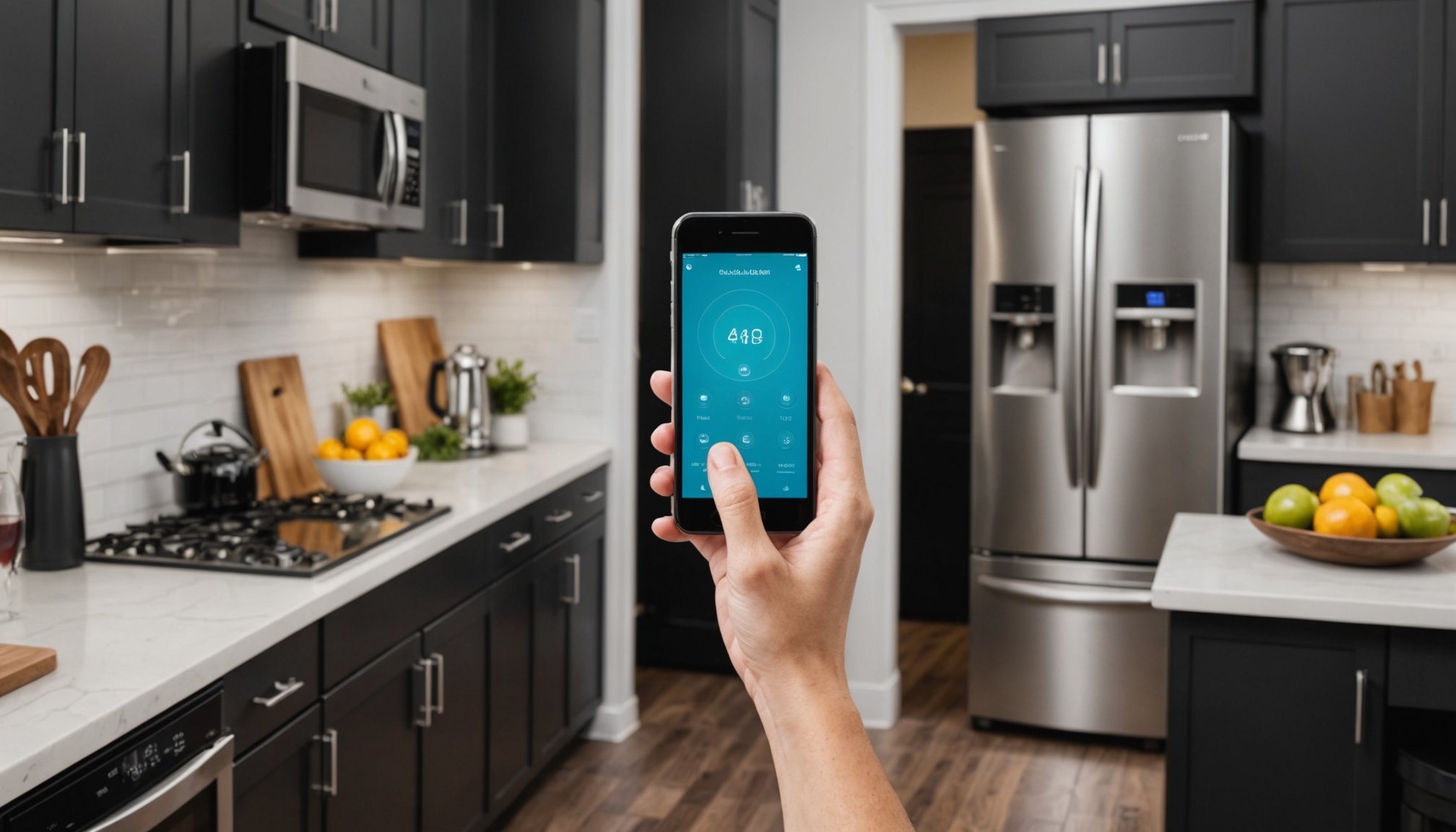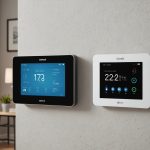Introduction to Smart Home Technology
Smart home technology, a blend of innovation and convenience, has evolved significantly over the years. It revolves around home automation and leverages IoT devices to transform daily life. These advancements connect appliances and electronics, making them accessible and controllable via smartphones or voice commands, no matter your location.
The benefits of automating home appliances extend beyond mere convenience. Imagine adjusting the thermostat from miles away, or having lights turn on as you pull into the driveway. These practical applications not only enhance comfort but also boost energy efficiency by tailoring the use of devices to your needs, cutting down on needless power consumption.
Also read : Revolutionize Your Water Filtration: Seamless Smartphone Control for a Smarter Home
A smart home ecosystem comprises multiple elements, bringing together devices like smart thermostats, lights, and locks to create a seamless living experience. Such ecosystems, supported by wireless technology, are overseen by central hubs or platforms, providing coherent control over various components. Brands like Google, Amazon, and Apple offer robust ecosystems that allow homeowners to integrate and manage devices easily.
In summary, smart home technology promises a future of effortless control, efficiency, and security—elements highly desirable in today’s fast-paced world. This evolution in home environments continues to develop, creating homes that are not just buildings, but interactive systems.
Also read : Master Your Indoor Climate: Seamless Smart HVAC Management and Monitoring at Your Fingertips
Choosing the Right Smart Home Devices
Selecting the right smart home devices is crucial for creating an efficient and seamless living environment. When choosing smart appliances and gadgets, consider their compatibility with your existing ecosystem, whether it’s Google Home, Amazon Alexa, or Apple HomeKit. Ensure the devices you select can integrate flawlessly, allowing for streamlined control.
Ease of use is another vital factor. Opt for devices with intuitive interfaces and setup processes, reducing the hassle of installation and daily operation. Look for products that enhance user experience through straightforward navigation and responsive support. Popular brands like Google, Amazon, and Apple offer distinct features that cater to various preferences and technological needs.
Each brand brings unique strengths. Google Home impresses with its robust search engine integration, providing users with efficient and versatile control. Amazon Alexa stands out for its wide range of compatible devices and third-party integration, enhancing entertainment and automation. Apple HomeKit is known for its privacy-focused design and seamless integration within the Apple ecosystem, offering a high level of security and user experience.
By evaluating these factors, you can make informed decisions. Choose devices that align with your lifestyle and technological preferences, ensuring a comprehensive and personalized smart home experience.
Setting Up Your Smart Home
Establishing a smart home setup involves meticulous planning and execution to ensure seamless functionality. Ensuring network stability is crucial; a robust Wi-Fi connection lays a strong foundation, allowing for hassle-free communication between devices. Before diving into the installation guide, gather essential tools: a reliable internet router, a smartphone or tablet, and relevant user manuals.
Preparing for Installation
Before setting up your smart home, begin by assessing your network’s capabilities. This involves checking your Wi-Fi strength and potentially investing in a high-speed router if needed. Also, familiarize yourself with the installation requirements for each device, as they may vary. Gathering the correct tools in advance will facilitate a smooth setup process.
Step-by-Step Installation Guide
Start with setting up your central hub, frequently a smart speaker or hub device. Follow the manufacturer’s installation guide, typically requiring connection to your home network and configuring settings through a smartphone app. For smart thermostats, lights, or locks, connect each device to the app, securing them within your existing network.
Troubleshooting Common Issues
Connectivity issues are prevalent but manageable. In case of problems, resetting the device and reconnecting it to your network can often solve the issue. Ensure firmware and app updates are current to maintain device compatibility and efficiency-enhancing features.
Controlling Your Appliances
Controlling your smart home appliances offers a unique blend of convenience and technological prowess, largely facilitated through voice commands and smartphone control. Voice assistants like Amazon Alexa, Google Assistant, and Apple’s Siri empower users to manage everyday tasks with simple verbal instructions. For instance, you can command, “Alexa, turn off the living room lights,” or “Hey Siri, adjust the thermostat to 22 degrees,” showcasing practical applications for a range of scenarios.
Voice Assistants and Their Capabilities
Voice assistants serve as the linchpin in optimizing appliance automation. Beyond toggling devices on and off, they orchestrate complex routines. A morning routine might include turning on lights, brewing coffee, and playing the news simultaneously. These capabilities tailor your environment to your preferences with minimal effort.
Smartphone Control and Automation
Smartphone apps, another control pillar, allow remote operation of home appliances. Whether you’re at home or halfway around the world, apps provide peace of mind and efficiency, offering real-time updates and control. Many apps provide user-friendly interfaces linking various devices, promoting tailored automation through integrated schedules and notifications. Embracing this dual-channel control system simultaneously ensures an adaptable and responsive smart home environment.
Comparing Smart Home Ecosystems
Smart home ecosystems are pivotal in establishing a unified and efficient smart home experience. They act as platforms that connect and control various IoT devices, streamlining automation processes. Popular ecosystems include Google Home, Amazon Alexa, and Apple HomeKit, each offering unique features to enhance user experiences.
Overview of Major Ecosystems
Google Home is renowned for its robust search capabilities and seamless integration with Google services, offering users versatile control and extensive device compatibility. Its ecosystem supports a broad range of products, making it adaptable for diverse smart home technology needs.
Conversely, Amazon Alexa is praised for its extensive third-party integration and substantial range of compatible devices. This ecosystem is particularly noted for its voice command functionality, simplifying and enhancing home automation.
Apple HomeKit stands out with a strong emphasis on privacy and security, seamlessly integrating within the existing Apple ecosystem. Its user experience is enhanced by an intuitive interface designed to maintain device compatibility and optimize control.
Cost Considerations
While initial costs for setting up different ecosystems vary, factors like usability, security, and long-term maintenance impact overall expenses. Smart home technology not only requires an initial financial commitment but also includes ongoing expenses for maintenance and upgrades. Users should weigh these cost considerations alongside platform features to identify the best fit for their needs.
Enhancing Your Smart Home Experience
Transforming your home into a smart haven goes beyond basic automation. Advanced automation options offer a tailored experience, making daily routines seamless and personal. These adaptations let you control multiple elements with a single command. Imagine uttering “Goodnight” and seeing lights dim, doors lock, and the thermostat adjust to your preferred night temperature.
Personalization plays a pivotal role in a refined user experience. Through customization, smart home systems can cater to specific needs, such as setting morning alarms alongside starting the coffee machine or adjusting blinds to let in natural light. Such functionality ensures that a home is not only connected but inherently responsive to its inhabitants.
Regular updates and maintenance are essential for the longevity and efficiency of your smart setup. Manufacturers often release updates to improve user experience, security, and device functionalities. Ensuring your devices are updated with the latest firmware guarantees not just new features but also enhanced protection against potential breaches.
For advanced automation, explore systems that provide feedback and analytics on usage. These insights can optimize energy consumption and highlight areas for further customization. Stay proactive in maintaining your system through regular reviews and adjustments for a truly interactive and responsive home environment.
Visual Aids for Understanding Smart Home Setup
Leveraging infographics and video guides can significantly enhance comprehension of smart home setups. These visual aids break down complex procedures, making them easier to follow. Infographics, in particular, provide a snapshot of the installation process or demonstrate connectivity solutions, which can be quickly absorbed.
Utilizing Infographics
Infographics are invaluable for those who prefer quick, graphical interpretations. They can succinctly illustrate the relationships between different IoT devices and their roles in a smart home. Effective infographics are colourful, concise, and targeted, simplifying even the most intricate systems into bite-sized visuals that guide users step by step.
Creating Video Tutorials
Videos excel at delivering detailed instructions and engage viewers with step-by-step demonstrations. For example, a video might show how to connect a new smart thermostat to an existing network. The practical aspect of seeing an installation in real time provides clarity. User-generated content often includes tips and tricks from personal experiences, adding another layer of relatability.
Resources for Additional Learning
For ongoing education, websites and forums dedicated to smart home technology are excellent resources. Engaging with these platforms keeps you updated on the latest trends and technologies. Recommended resources cover everything from basic automation to advanced customization, supporting continuous learning and adaptation.











